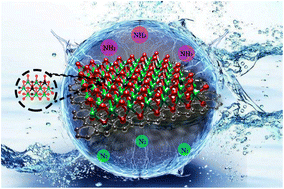Coral-like Fe-doped MoO2/C heterostructures with rich oxygen vacancies for efficient electrocatalytic N2 reduction†
Abstract
Molybdenum (Mo) is one of the most important constituent elements in natural nitrogenase and theoretical calculation results show that Mo-based materials can be used as potential NRR electrocatalysts. The design of advanced catalysts with a special structure is very essential for promoting the development of electrocatalytic N2 into NH3. In this paper, Fe-doped MoO2/C heterostructured nanoparticles with rich oxygen vacancies (Vo) are designed and they exhibit highly efficient catalytic activity for artificial N2 fixation in neutral electrolytes under ambient conditions. The influence of the atomic ratio of the Fe source to the Mo source and the NaBH4 ethanol solution treatment on the structure and electrocatalytic performance are systematically investigated. The Vo-Fe–MoO2/C (1 : 50) catalyst with rich oxygen vacancies shows a satisfactory electrocatalytic N2 reduction reaction (e-NRR) activity in 0.1 M Na2SO4 with a high ammonia yield rate of 15.87 ± 0.3 μg h−1 mg−1 at −0.5 V versus the reversible hydrogen electrode (vs. the RHE) and a FE of 13.4% at −0.3 V (vs. the RHE). According to the results of DFT calculations, the active center of the electro-catalytic nitrogen reduction reaction is the molybdenum atom between the iron atom and the O vacancy. Oxygen vacancies can not only reduce the energy barrier of the RDS but also facilitate the desorption of ammonia and the first step hydrogenation of nitrogen. The doping of Fe will change the electronic state of the Mo atom in MoO2.



 Please wait while we load your content...
Please wait while we load your content...